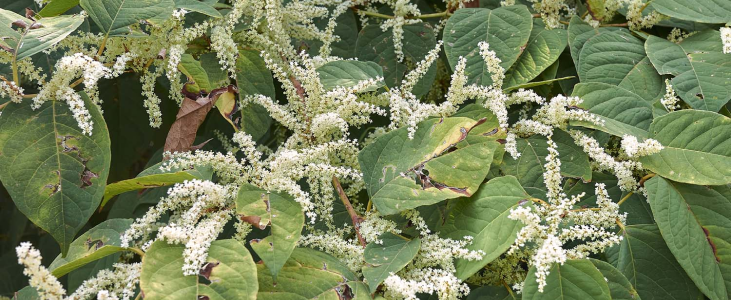88. Japanese Knotweed
Japanese knotweed is a highly invasive and fast-growing plant species that can cause significant damage to properties and infrastructure.
Appearance
Japanese knotweed (Fallopia japonica) is a perennial plant with bamboo-like stems, heart-shaped leaves, and clusters of small white flowers. It typically grows rapidly from early spring to late autumn, forming dense thickets that can quickly overrun gardens, driveways, and even buildings.
You can identify Japanese knotweed by its distinctive features, including its hollow stems, alternating leaves arranged in a zigzag pattern along the stem, and reddish-purple shoots emerging in spring.
Property impact
Japanese knotweed can cause significant damage to buildings, foundations, and underground services. Its aggressive root system can penetrate through cracks in concrete and asphalt, causing structural damage and undermining the stability of structures.
The presence of Japanese knotweed on a property can also devalue the property and make it difficult to sell, as lenders and insurers may be hesitant to provide financing or coverage for properties affected by this invasive plant.
Identification on your property
You can check for signs of Japanese knotweed on your property by inspecting areas where it typically grows, such as along boundaries, fences, walls, and disturbed ground. Look for the characteristic growth pattern, stems, leaves, and flowers described earlier.
If you suspect Japanese knotweed is present on your property, it is advisable to seek confirmation from a qualified expert, such as a Japanese knotweed specialist or a professional surveyor experienced in invasive plant identification.
Management and control
If Japanese knotweed is confirmed on your property, it is essential to take action to prevent its spread and minimise its impact. Treatment methods may include chemical herbicides, mechanical removal, and physical barriers.
Effective management and control of Japanese knotweed often require ongoing efforts over several years, as the plant's rhizomes (underground stems) can persist and regrow even after initial treatment.
Insurance coverage
Some insurers offer specialist Japanese knotweed insurance policies that provide coverage for the costs of treatment, removal, and potential damage caused by Japanese knotweed on your property. These policies may also cover legal expenses associated with disputes or liability claims related to Japanese knotweed.
When purchasing property or renewing your existing insurance policy, it is essential to check whether Japanese knotweed coverage is included or available as an optional add-on, especially if your property is located in an area known for Japanese knotweed infestations.
Impact on property sale
The presence of Japanese knotweed can have a significant impact on the saleability and value of a property. Prospective buyers may be deterred from purchasing a property affected by Japanese knotweed due to concerns about potential damage, liability, and difficulty obtaining financing or insurance.
Sellers are legally obligated to disclose the presence of Japanese knotweed on their property to potential buyers, and failure to do so could lead to legal disputes and financial liabilities.
To mitigate the impact on property sale, sellers may need to undertake treatment and remediation measures to control Japanese knotweed infestations and provide documentation and assurances to reassure buyers and lenders about the property's condition and future management plans.

